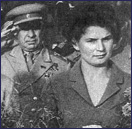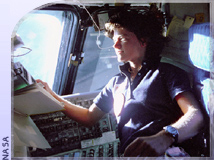
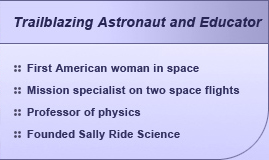
Millions of little girls are going to sit by their television sets and see they can be astronauts, heroes, explorers and scientists.
—Gloria Steinem on Ride’s historic first flight
On June 18, 1983, the space shuttle Challenger soared into orbit with five people aboard. Among them was flight engineer Sally Ride, the first American woman to travel into outer space. As the craft entered the outer atmosphere, Ride completed her official ascent checklist and asked Roy Bridges, the crew communicator back on Earth, if he’d ever been to Disneyland. “Affirmative,” replied Bridges. Ride responded, “This is definitely an E-ticket.”
That Ride, a 32-year-old astronaut and physicist, chose to compare her first experience in space to a theme-park ride is apt—for her, science and space exploration have always been thrilling adventures.
After completing her work with NASA (including two space shuttle missions), Ride became an educator devoted to inspiring women and girls to explore the sciences through her company, Sally Ride Science. Says Ride, “Starting Sally Ride Science was a way to make a difference. Plus it’s just great fun!”
Early Love
Sally Kristen Ride was born to parents Dale and Joyce Ride on May 26, 1951, in Encino, California. As a teen, Ride showed promise as a tennis player, taking lessons from Alice Marble and competing on the junior tournament circuit. She attained a national rank of 18 in her age group, and tennis champion Billie Jean King (who also trained with Marble as a teen) reportedly urged her to turn pro.
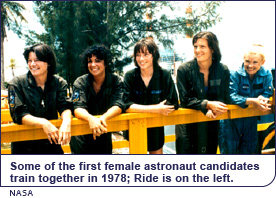 But in her junior year of high school, Ride took a physiology class that sparked a lifelong love of science. She went on to study science—and Shakespeare—at Stanford University. Ever the athlete, she also found time to play women’s rugby. In 1973, she graduated with two degrees, a BA in English and a BS in physics.
But in her junior year of high school, Ride took a physiology class that sparked a lifelong love of science. She went on to study science—and Shakespeare—at Stanford University. Ever the athlete, she also found time to play women’s rugby. In 1973, she graduated with two degrees, a BA in English and a BS in physics.
Ride decided to continue her studies, focusing on X-ray astronomy and free-electron lasers in graduate school at Stanford. While working on her dissertation, she opened the Stanford newspaper and read an ad that would change her life. NASA was looking for scientists who wanted to become astronauts; women were urged to apply. As Ride later told the New York Times, “I looked at that list of credentials and said, ‘I’m one of those people.’”
After competing against 8,370 other candidates for 34 spots, Ride was one of six women selected to become astronauts. In 1978, she received her PhD in physics and began her NASA training. In a rigorous one-year program, Ride completed her training, obtaining her pilot’s license and earning the title of shuttle mission specialist.
We Have Lift-Off
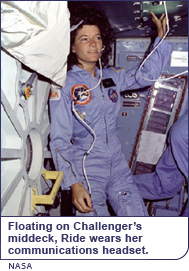 Ride’s first space flight was a six-day orbit aboard the space shuttle Challenger. Launched from Kennedy Space Center in Florida on June 18, 1983, this was the first U.S. shuttle flight with a female astronaut on board, and while NASA tried to tame the press’s interest in Ride’s gender, she was clearly the mission’s lead story. As Robert Crippen, the mission’s commander, jokingly put it, “…in the media, the crew was known as Sally Ride and the Others.” During the mission, the crew deployed communications satellites (using the shuttle’s robot arm) and conducted materials and pharmaceutical research.
Ride’s first space flight was a six-day orbit aboard the space shuttle Challenger. Launched from Kennedy Space Center in Florida on June 18, 1983, this was the first U.S. shuttle flight with a female astronaut on board, and while NASA tried to tame the press’s interest in Ride’s gender, she was clearly the mission’s lead story. As Robert Crippen, the mission’s commander, jokingly put it, “…in the media, the crew was known as Sally Ride and the Others.” During the mission, the crew deployed communications satellites (using the shuttle’s robot arm) and conducted materials and pharmaceutical research.
Ride was hooked on space travel and took a second mission on Challenger less than a year later. This time, Ride wasn’t the only woman on board: Astronaut Kathryn Sullivan also joined the crew. For the first time, two women flew together into space (and on this voyage, Sullivan became the first American woman to walk in space). During the eight-day mission, the crew deployed the Earth Radiation Budget satellite, conducted scientific observations of the Earth and demonstrated the potential for satellite refueling by astronauts.
In June 1985, Ride was assigned to serve as a mission specialist on a third space-shuttle flight, but her training was interrupted by a tragedy. On January 28, 1986, Challenger exploded 73 seconds into the lift-off of its tenth mission, killing all seven astronauts on board. Ride terminated mission training to serve as a member of the presidential commission investigating the disaster.
A New Mission
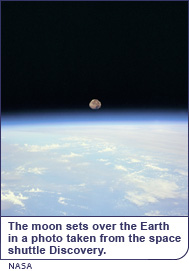 After the Challenger investigation, Ride was assigned to NASA headquarters in Washington, D.C., as special assistant to the administrator for long-range and strategic planning. There, she issued a report with recommendations for the organization’s future (commonly referred to as the Ride Report). In 1987, she resigned from NASA for a two-year fellowship at Stanford. Since 1989, she has been a professor of physics at the University of California, San Diego (UCSD). “Sally’s a hero at bringing the excitement of science into the classroom,” former UCSD chancellor and current UC president Robert Dynes told the Los Angeles Times.
After the Challenger investigation, Ride was assigned to NASA headquarters in Washington, D.C., as special assistant to the administrator for long-range and strategic planning. There, she issued a report with recommendations for the organization’s future (commonly referred to as the Ride Report). In 1987, she resigned from NASA for a two-year fellowship at Stanford. Since 1989, she has been a professor of physics at the University of California, San Diego (UCSD). “Sally’s a hero at bringing the excitement of science into the classroom,” former UCSD chancellor and current UC president Robert Dynes told the Los Angeles Times.
Ride’s passion for science and desire to provide support for girls in the field prompted her to found Sally Ride Science. To encourage elementary- and middle-school girls in science, math, engineering and technology, Sally Ride Science sponsors festivals and hands-on science camps for girls. Just as she opened up the possibility of space travel for female astronauts, Ride hopes to transform science by inspiring a new generation of girls to stellar careers in the field.
:: Maureen Russell
Read More About Sally Ride





